1978 Canadian Grand Prix race report
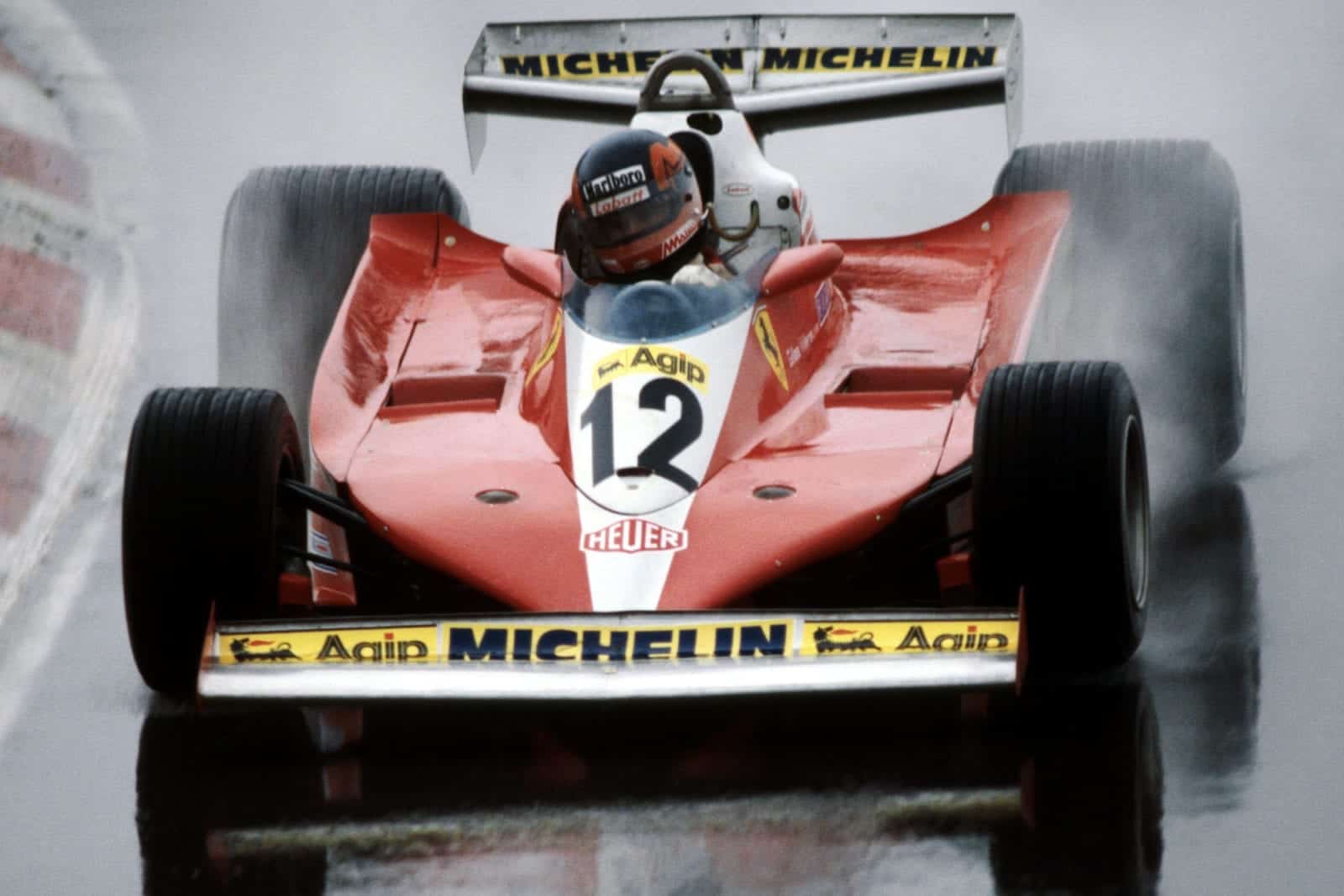
Ferrari's Gilles Villeneuve took a debut win on home soil
Motorsport Images
Villeneuve at home
Montreal, October 8th
One week after the United States Grand Prix took place at Watkins Glen, the Grand Prix circus arrived to “pitch tent” in the new surroundings of the Ile Notre-Dame circuit, an artificial road course made up of access roads round a small island in the St. Lawrence River a stone’s throw from the centre of Montreal. This was the third venue for the Canadian race since its inclusion in the World Championship series 11 years ago, most of the races taking place at the Mosport Park circuit not far from Toronto. Twice the race was held at the St. Jovite circuit, to the north of Montreal, but since 1971 it has been at Mosport with a gap in 1975 when there was an argument between the teams and the organisers. The teams returned to Mosport in 1976 and 77, but it was becoming clear that discord was fast developing between competitors and circuit owners, so this year the race moved to Montreal.
Against the backdrop of Montreal’s “high rise” office blocks and hotels, the 2.796-Mile Ile Notre-Dame track winds and twists as way round dilapidated structures built for the “Expo ’67” exhibition 11 years ago as well as facilities provided for the more recent Olympic Games. Two weeks before the Grand Prix was scheduled to take place, the track received its “regulation baptism” when a Canadian national F/Atlantic event took place. Two drivers, Rosberg and Rahal, took part in this inaugural race and adjudged the circuit pretty tight and tortuous in F/Atlantic single-seaters so there was speculation that nobody would be able to get past when it came to running 3-litre Formula One cars round it!
After the Watkins Glen race there was a predominantly “end of term” feeling amongst all those teams, drivers, mechanics, journalists and hangers on who’d been following the World Championship trail since it began in sunny Argentine last January, seemingly an age ago. But there were still one or two interesting changes for the final race of the season, not to mention a spectacular (but in no way unexpected) decision from Goodyear to initiate development and tyre supply contracts with nine specific teams and leave the rest to either buy their own rubber or find an alternative supplier. The fortunate teams were Arrows, Brabham, Copersucar, Lotus, Tyrrell, McLaren, Ligier, Williams and Wolf.
Minor changes to the entry list included the addition of Brazilian F3 star Nelson Piquet in the spare Brabham BT46, this promising youngster taking over from Watson as Lauda’s number two next year. Piquet had been entered provisionally at Watkins Glen, but subsequently withdrawn, but once the American race was over and all three Brabham chassis emerged in one piece, Ecelestone decided to give his new recruit a run in Canada. It was emphasised, of course, that the two established team members would have first choice in the use of Piquet’s car as a spare if necessary. Tambay decided to switch back to McLaren M26/3 after driving the ex-Giacomelli M26/7 at Watkins Glen while Andretti began practice at the wheel of Lotus 79/1 while Jarier went back to using 79/3 which had been “snatched” from him by the new World Champion after 79/4 was crashed in the race morning warm up at Watkins Glen. 79/4 was repaired and ready for Andretti’s use when he required it. In the Ensign camp there was just one entry for Daly, Morris Nunn feeling that it was best to keep a spare chassis on hand for the Dubliner.
To compound the tight and twisting nature of this new circuit, torrential rain virtually washed out the two sessions of practice on Friday, there being a brief respite for ten minutes or so right at the end of the Friday afternoon spell. Even then, it was a question of “being ready to go” at the right moment and keeping in the dry groove which successive cars had produced round the circuit. Surprisingly, the three Brabham runners were not ready and found themselves caught on the hop with the result that none of them had qualified at the end of the first day.
Qualifying
Fortunately, practice didn’t turn out to be that illogical and the conditions dried out on Saturday afternoon. Thus the status quo was largely restored, although the grid provided some surprises with strange faces in unfamiliar places. But, in reality, Friday’s times were irrelevant and only indicated who had the bravado and temperament for effective wet weather driving.
In both saturated sessions, Michelin’s wet weather tyres were a major factor in helping the Ferrari 312T3s of Reutemann and Villeneuve to dominate the proceedings. Reutemann was quickest in the first session in 2 min, 02.578 sec. (a comparison with the F/Atlantic dry weather fastest lap of 1 min. 44.650 sec. indicates just what the conditions were like), with his young French Canadian team-mate just over a second slower, a reflection, perhaps, of his less sympathetic use of the throttle. Even taking into account the drier conditions right at the end of the second session, those two Italian flat-12s continued to hold sway throughout the afternoon, Reutemann improving to 1 min. 57.940 sec. and Villeneuve to 1 min. 58.605 sec.
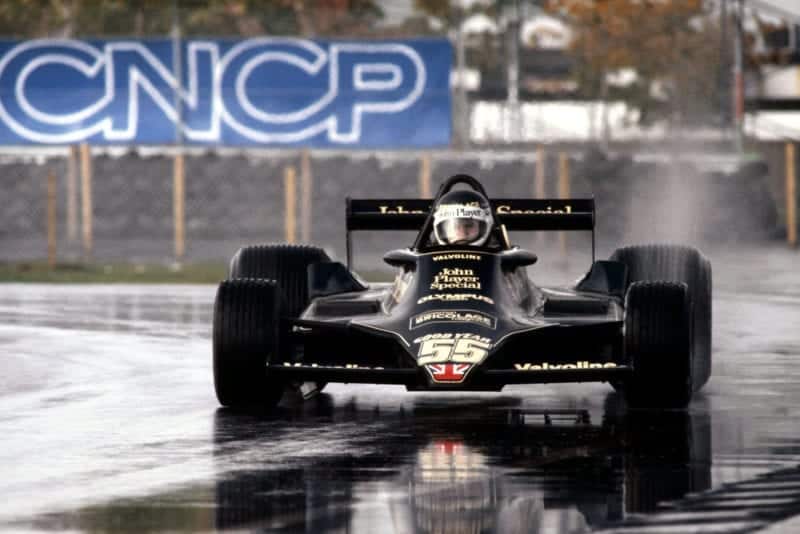
Ronne Peterson-replacement Jean-Pierre Jarier took pole for Lotus
Motorsport Images
Andretti took his 79/1 round in 1 min. 59.150 sec., so prospects looked quite good for Lotus, while the lanky Hans Stuck, a great enthusiast in the wet, splashed his Shadow DN9 happily round in 1 min. 59.150 sec., his quick reflexes coping superbly with the slippery surface. Then came Jody Scheckter in the Wolf WR6 (1 min. 59.916 sec.) and Jarier who was once again proving himself at home in the cockpit of a Lotus 79. The Frenchman recorded a 2 min. 00.214 sec. which was fractionally faster than Alan Jones could manage in his newly rebuilt Williams FW06/002 which had been reassembled round a fresh monocoque following its trip into the catch fences during practice at Watkins Glen. His best was 2. min. 00.244 sec., just in front of Daly’s Ensign MN06, the Irish driver intending to start the day at the wheel of MN07 but finding the clutch mechanism locked solid when he tried to drive it away at the start of the first session. He thus transferred immediately to MN06, proving Nunn’s decision to run a single entry to be a wise one.
There were one or two others to demonstrate commendable form in the wet, notably Rosberg in his ATS D1, the Finn managing a 2 min. 02.014 sec., while Surtees drivers Gabbiani and Arnoux were well in the swim of things in the middle of the practice lists. It was all good, spray-raising fun although a little irrelevant to the serious business of the weekend, and the whole episode was proving highly frustrating to the Renault organisation with Jabouille struggling away at the back, apparently with little chance. After the team’s fourth place finish at Watkins Glen, Montreal provided a big let-down because the tight, twisting circuit in the pouring rain posed just about the most singularly unsuitable conditions for the 1 1/2-litre V6 turbocharged engine to operate in. Even when the circuit dried out on Saturday, Jabouille was destined to be the last qualifier on the grid.
Of course, in such dismal conditions, there was a surplus of off-course casualties as everybody splashed about in the spray, trying to avoid each other as well as keeping off the high kerbs and muddy run-off areas. Those who fell foul of the diabolical conditions included Piquet who ran BT46/5 gently off the road on Friday afternoon, bending the right front corner as a result, plus Bleekemolen’s ATS (which bent the front of its monocoque) and Laffite in the Ligier. The French driver’s excursion was a little more complicated and resulted in the session briefly coming to a halt. The Ligier driver spun JS9/02 into the guard-rail and then attempted to drive back to the pits, not knowing that the impact had dislodged a gearbox oil plug. Within a few hundred yards the gearbox seized solid and the blue car ground to a halt in the middle of the track!
Regazzoni crashed his Shadow DN9 which was particularly frustrating as the mechanics had rebuilt his machine round the monocoque of DN9/4A-4 since Watkins Glen, his previous machine having kinked its monocoque over a kerb at the American track. So now the team had two bent monocoques out of which to reassemble a car for the Swiss and close examination confirmed that it would be easiest to reassemble the DN9 with its Montreal damaged tub. That’s what they did, but Regazzoni couldn’t qualify the machine.
Tambay found himself climbing back into the unloved M26/7 after an oil line fractured on M26/3, Rosberg had gearbox problems on the ATS and Rahal crashed his Wolf WR5 too badly to repair for Saturday. As a result, the Wolf team had to reclaim the original WR1 chassis, which was on display in the foyer of a Montreal hotel, and work through the night preparing the car for Rahal to practise on Saturday. Award for the most unfortunate spinner went to Lotus privateer Rebaque who rotated twice on his own and once with some assistance from Daly.
Although the track dried out for the final hour of practice on Saturday afternoon, there was a biting cold wind and the threat of snow from the north. Villeneuve set the pace in that final hour, recording 1 min. 38.230 sec. in his Ferrari and it looked for a long time as though it would be quick enough to take pole position. But Jody Scheckter got himself well wound up in his Wolf to record 1 min. 38.026 sec. and then Jarier eclipsed both of them with a stupendous 1 min. 38.015 sec. which left people wondering just what sort of “magic machine” Chapman had evolved in the Lotus 79.
Villeneuve retained third place on the grid, feeling that he lost out slightly because his Ferrari was fitted with softer brake pads for the rain, but he still qualified for the second row just in front of Watson, the fastest of the Brabham-Alfa Romeo runners who recorded 1 min. 38.417 sec. Alan Jones ran out of fuel near the end of the session, making him very annoyed, and he did a 1 min. 38.861 sec. Then came several people with minor “niggles”, notably Fittipaldi on 1 min. 38.930 sec., frustrated with a water leak, and Lauda on 1 min. 39.020 sec., complaining that his Brabham wouldn’t turn into slow corners as he would like.
Completing the fourth row was a very happy Hans Stuck but Andretti was back on the fifth row on 1 min. 39.236 .sec., the World Champion’s two days of practice frustrated by a minor balance problem in 79/4 (to which he’d switched on Saturday), the difficulty subsequently traced to incorrect camber adjustments although practice was over before this was found out. Then came Laffite and a deflated Reutemann, unable to understand why his Ferrari felt so abominable.
Patrese was another to run out of petrol, but he still managed to beat Depailler and the cautious Piquet who was “playing himself in” with caution and commendable respect. Daly qualified ahead of Arnoux and both McLaren drivers were in trouble. Hunt had to take the spare M26/7 after M26/5 stopped out on the circuit with throttle control disorders and Tambay ran over the back of Rebaque in one of the hairpins, bending a front rocker arm on his M26/3. Rahal qualified the old Wolf while Rosberg and Jabouille shared the back row of the grid, both disappointed. Non-qualifiers included Regazzoni, Gabbiani, Stommelen, Rebaque, Merzario and Bleekmolen, an interesting mixture.
Race
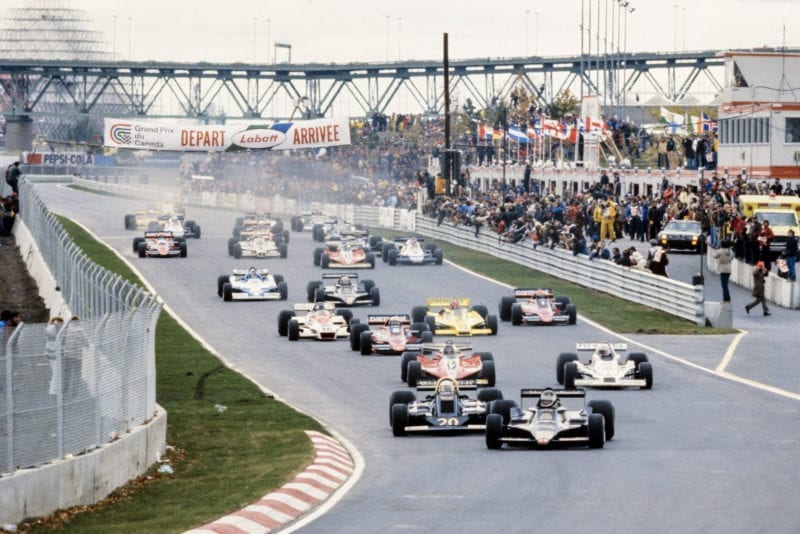
Jarier leads at the start
Motorsport Images
Thankfully, race morning dawned dry and blustery which was a good omen for the thousands of French-Canadian enthusiasts who poured into the circuit to cheer their hero Villeneuve. A welcome cache of respectability was bestowed on the event by the presence of Canada’s progressive and popular Prime Minister, Pierre Trudeau, and it was the nation’s Premier who waved the 22 cars away on their parade lap before the official starting signal was given.
Jarier made the best start, leading Scheckter into the fast right-hander beyond the pits with Jones and Villeneuve side-by-side in their wake. As they braked for the left-hander into the first chicane, Stuck came barging through, spinning his Shadow in the middle of the pack and forcing Fittipaldi off the circuit and into the catchfencing. Laffite also got involved but quickly resumed the chase, leaving Stuck to trail dejectedly back to the pits where he retired with damaged suspension and steering. Fittipaldi, absolutely furious with the German driver’s behaviour, ended his race there and then amidst the catch-fencing. At the end of the first lap the order was Jarier, Jones, Scheckter, Villeneuve, Watson, Andretti, Depailler, Lauda, Reutemann and the rest.
There was no catching Jarier for the Frenchman had opened a two second gap over Jones by the end of lap one, rushing away into the distance in brilliantly smooth and controlled style. With three laps completed he had almost seven seconds over the Williams driver and he progressively opened out his advantage until he was 13 seconds in front after as many laps.
Jones initially held a strong second place, the strong Australian driver feeling well able to cope with both Scheckter and Villeneuve who were close behind. Unfortunately he realised that a rear tyre was losing pressure after only five laps and, after an increasingly difficult battle, he was forced to give best to both Wolf and Ferrari. By lap 19 he had faded to fourth place.
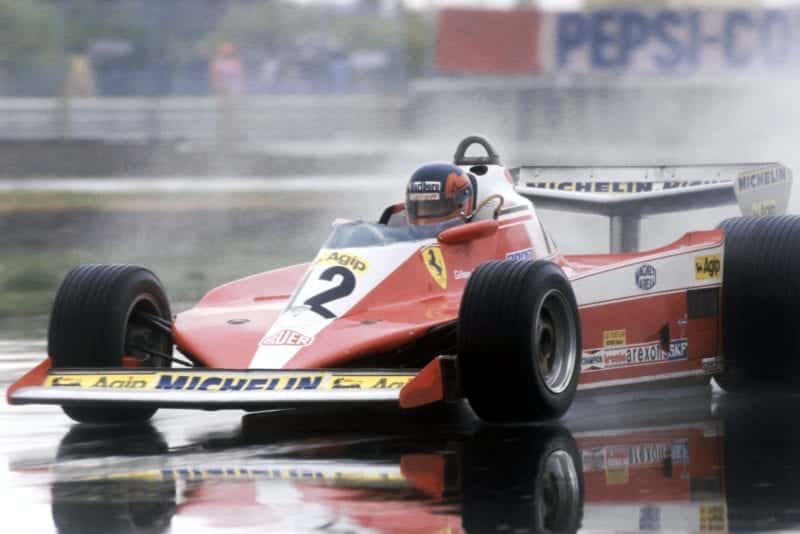
Villeneuve made good on earlier promise shown by taking the race win
Motorsport Images
Meanwhile, further down the field there was trouble with Andretti attempting to slip up the inside of Watson at the hairpin as the field completed lap five. There wasn’t sufficient room for an audacious manoeuvre of that nature and the Lotus made firm contact with the Brabham, both cars spinning to a halt facing each other on opposite sides of the circuit. Despite trying to dissuade the marshals, both cars were push-started to get them out of their predicament (they didn’t want to fire up on their starters, anyway). Watson came straight into the pits, resumed the race and retired three laps later with damaged rear suspension, while Andretti continued almost a lap down on the leader.
On lap ten Rahal made the first of three pit stops to investigate intermittent misfiring on his Wolf WR1, a problem that eventually led to his retirement after 16 laps. It seemed likely that one of the flap valves in the fuel system was somehow sticking, possibly the legacy of WR1’s long layoff from active service. A lap later Laffite came in to change both rear wheels, suspecting one of them to have worked loose in the first-lap incident.
A lap later Depailler came past the pits pointing at his front tyres, indicating to his mechanics that the softer compound Goodyears had chosen to run were not lasting up to the pressure of the race. On lap 17 the blue Tyrrell came rolling into the pit lane, both front wheels were changed, and the Monaco winner was back in the fray down in 13th position, set for a fine climb back through the field.
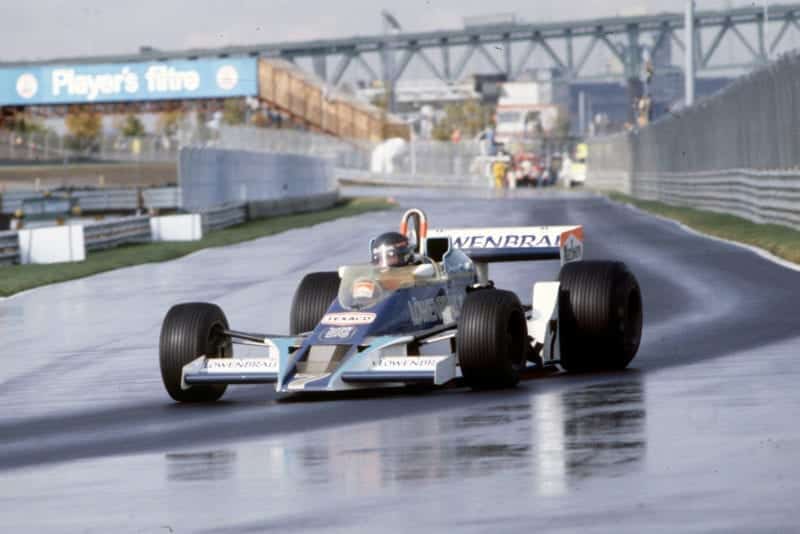
A spin put paid to James Hunt’s chances in the blue McLaren
Motorsport Images
Lauda had gone from the lap charts shortly after team-mate Watson, his Brabham out of brakes, so the sense of disappointment in Ecclestone’s camp was magnified when Piquet suddenly dropped back from seventh to 11th as he began to experience difficulty in selecting gears. He kept going as well as he could, watching his mirrors to make sure he didn’t badly baulk faster cars, something he generally managed to avoid doing although he did chop off Scheckter quite badly on one occasion.
With 20 laps of the race completed Jarier was holding sway at the head of the field, not looking in the least flustered as he steered his Lotus between the chicane kerbs with considerable precision, Scheckter was second, then Villeneuve, Jones, Reutemann, Daly, Patrese, Rosberg, Pironi and Tambay. On lap 27 Reutemann took fourth place from the still-slowing Jones while Rosberg brought the ATS into the pits with a bad misfire that took three pit stops to cure, eventually being traced to a problem with the fuel metering unit which had to be changed. Jones could stay out with that deflating tyre no longer than 33 laps, so then he came in for fresh rubber all round. Thus equipped, Jones returned to the race to establish the first official F1 record for the Ile Notre-Dame circuit, lapping in 1 min. 39.072 sec. despite the fact that he had to hold the car in third gear and hadn’t got an operational fifth gear at all. As he remarked afterwards, that was a reflection of just how well the Williams was handling on the Montreal track!
Scheckter was chasing as hard as he could in second place, but he wasn’t making any impression on Jarier’s advantage and it seemed as though Colin Chapman’s “stand in” was on the way to scoring the team’s ninth victory of the season out of 16 races. But, sadly for the Frenchman, things were not going to work out like that. Half-way round lap 46 Jarier felt his car sliding about a bit more than usual and when he pressed the brake pedal he realised that they were not as effective as they had been. There was an oil leak onto the rear brakes and, two laps later, the loss of lubricant began to show up on the oil-pressure gauge. Then, at the end of lap 49, it was all over and Jarier quietly brought his Lotus into the pits to save blowing its engine apart, stepping out of the cockpit to be consoled by Colin Chapman after a very worthy effort indeed.
Thus, with 21 laps to go, Gilles Villeneuve was leading his home Grand Prix and the crowds went wild with excitement and delight. It would have been so easy for the young French-Canadian driver to get over-excited in such a situation and perhaps throw the whole thing away by clipping a wheel against one of the many guard-rails that line the circuit. But, as he proved at Long Beach and Monza, Villeneuve is a very cool customer indeed and doesn’t easily become flustered. He held himself carefully in check for the remainder of the race and came home to take the chequered flag, a delighted and satisfied winner of his home Grand Prix.

Villeneuve is interviewed by Jackie Stewart after winning
Motorsport Images
Reutemann was catching Scheckter towards the finish, but the Wolf driver hung on to finish a strong second while Patrese who’d taken every step to keep out of trouble, boosted his rather shaken confidence by coming home fourth in his Arrows A1. Depailler was really wound up after his pit stop for tyres and came rocketing back to fifth, just in front of Derek Daly’s Ensign, the Irish driver driving well just as he had done at Watkins Glen. Eighth was Tambay, nursing fading brakes, in front of Jones and Andretti, while Piquet and Jabouille were running along with Rosberg, although the quick ATS driver was too far back to be classified. James Hunt spun off with under 20 laps to go while the impressive Arnoux stopped with engine failure after an early pit visit to change a bent steering arm.
After Villeneuve led the field for half the Long Beach race, D.S.J. commented in “Reflections in a Side Street” that “He’ll learn and he’ll win”. That’s exactly what the young French-Canadian driver proved in front of his home crowd at Montreal. Such is progress. – A.H.
